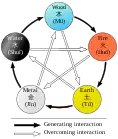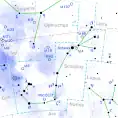火
| ||||||||
| ||||||||
Translingual
| Stroke order | |||
|---|---|---|---|
 | |||
Alternative forms
- 灬 (when used as a bottom Chinese radical)
Han character
| Stroke order | |||
|---|---|---|---|
火 (Kangxi radical 86, 火+0, 4 strokes, cangjie input 火 (F), four-corner 90800, composition ⿻⿰丿丿人(GJKV) or ⿻丷人(HT))
- Kangxi radical #86, ⽕.
Derived characters
- Appendix:Chinese radical/火
- 黑(黒)
- 伙, 吙, 𡵼, 𫹐, 𣲧, 狄, 阦, 𨑯, 𣃛, 𭨬, 𣏹, 𣧛, 𪵘, 𤘭, 𪻓, 𥘙, 𪼸, 𤰹, 疢, 𥄣, 秋, 𦈦, 耿, 𧺩, 鈥(钬), 𩖧, 𣺸, 𫘉, 𩲕, 𩵰, 𪌌
- 邩, 𤬬, 畑, 秌, 𦓒, 烙, 䙺, 𧣌, 𨚊, 𨟽, 䲴, 𠠽, 𪢾, 𡗩, 𣏦, 𣲱, 𦙊, 𭿿, 𮝃, 𬮟, 𡇂
- 𬽄, 灰, 𡭞, 𡵖, 𢏅, 苂, 𭭝, 𣱛, 𤽈, 𬔇, 荧, 𬔲, 羙, 䎡, 𬟩, 𧈾, 䙳, 𧿮, 倐, 𮦉, 𩇭, 𫳡, 𣣛, 𩬊, 𦎟, 𪎖, 𦹪, 𩃏, 齌, 䀆, 㴴, 燮
References
- KangXi: page 665, character 1
- Dai Kanwa Jiten: character 18850
- Dae Jaweon: page 1073, character 19
- Hanyu Da Zidian (first edition): volume 3, page 2187, character 1
- Unihan data for U+706B
Chinese
| trad. | 火 | |
|---|---|---|
| simp. # | 火 | |
Glyph origin
| Historical forms of the character 火 | ||||||
|---|---|---|---|---|---|---|
| Shang | Western Zhou | Spring and Autumn | Warring States | Shuowen Jiezi (compiled in Han) | Liushutong (compiled in Ming) | |
| Oracle bone script | Bronze inscriptions | Bronze inscriptions | Chu slip and silk script | Qin slip script | Small seal script | Transcribed ancient scripts |
 |  |  |  |  |  |  |
| Old Chinese | |
|---|---|
| 火 | *qʰʷaːlʔ |
| 邩 | *qʰʷaːlʔ |
| 伙 | *qʰʷaːlʔ |
Pictogram (象形) – pictographic representation of a fire.
Etymology
Possibly from Proto-Sino-Tibetan *mej (Schuessler 2007; STEDT). However, see there for phonological problems.
Pronunciation
Definitions
火
- fire; flame
- 可以跟你借一個火嗎? [MSC, trad.]
- Kěyǐ gēn nǐ jiè yīge huǒ ma? [Pinyin]
- Can I borrow a light?
可以跟你借一个火吗? [MSC, simp.]
- fire (as a disaster); inferno
- red; fiery; bright; brilliant
- to burn down
- light; torch
- (dialectal) light; lamp
- anger; rage; wrath
- to become enraged
- angry; furious
- (traditional Chinese medicine) internal heat
- firearm; ammunition; weapon
- war; warfare
- thriving; brisk
- urgent; pressing
- (neologism) to become popular; to go viral
- (neologism) to be popular; to be viral
- (Cantonese) watt (unit of power)
- ※Definitely, "火" here is a unit of brightness (luminous intensity). However, the brightness of a luminous device is measured in watts in life because of luminous intensity's dependence on power, which resulted in it being bonded to watt, the unit of power.
- 20火嘅燈膽/20火嘅灯胆 [Cantonese] ― 20 fo2 ge3 dang1 daam2 [Jyutping] ― 20-watt lightbulb
- Short for 火星 (Huǒxīng, “Mars”).
- (Cantonese) roasted
- Synonyms: 烤 (kǎo), 燒/烧 (shāo)
- 火鴨/火鸭 [Cantonese] ― fo2 aap3 [Jyutping] ― roasted duck
Synonyms
| Variety | Location | Words edit |
|---|---|---|
| Classical Chinese | 火 | |
| Formal (Written Standard Chinese) | 火 | |
| Mandarin | Beijing | 火 |
| Taiwan | 火 | |
| Tianjin | 火 | |
| Chengde | 火 | |
| Tangshan | 火 | |
| Cangzhou | 火 | |
| Baoding | 火 | |
| Shijiazhuang | 火 | |
| Chifeng | 火 | |
| Hulunbuir (Hailar) | 火 | |
| Heihe | 火 | |
| Qiqihar | 火 | |
| Harbin | 火 | |
| Jiamusi | 火 | |
| Baicheng | 火 | |
| Changchun | 火 | |
| Tonghua | 火 | |
| Shenyang | 火 | |
| Dandong | 火 | |
| Jinzhou | 火 | |
| Dalian | 火 | |
| Yantai | 火 | |
| Qingdao | 火 | |
| Lijin | 火 | |
| Jinan | 火 | |
| Jining | 火 | |
| Wanrong | 火 | |
| Shangqiu | 火 | |
| Yuanyang | 火 | |
| Lingbao | 火 | |
| Xinyang | 火 | |
| Baihe | 火 | |
| Hanzhong | 火 | |
| Xi'an | 火 | |
| Baoji | 火 | |
| Yinchuan | 火 | |
| Tianshui | 火 | |
| Lanzhou | 火 | |
| Dunhuang | 火 | |
| Xining | 火 | |
| Hami | 火 | |
| Ürümqi | 火 | |
| Wuhan | 火 | |
| Yichang | 火 | |
| Xiangyang | 火 | |
| Tianmen | 火 | |
| Hong'an | 火 | |
| Chengdu | 火 | |
| Nanchong | 火 | |
| Dazhou | 火 | |
| Hanyuan | 火 | |
| Xichang | 火 | |
| Zigong | 火 | |
| Chongqing | 火 | |
| Guiyang | 火 | |
| Zunyi | 火 | |
| Bijie | 火 | |
| Liping | 火 | |
| Zhaotong | 火 | |
| Dali | 火 | |
| Kunming | 火 | |
| Mengzi | 火 | |
| Guilin | 火 | |
| Liuzhou | 火 | |
| Jishou | 火 | |
| Changde | 火 | |
| Anqing | 火 | |
| Xuzhou | 火 | |
| Fuyang | 火 | |
| Wuhu | 火 | |
| Yangzhou | 火 | |
| Lianyungang | 火 | |
| Lianshui | 火 | |
| Nanjing | 火 | |
| Hefei | 火 | |
| Nantong | 火 | |
| Singapore | 火 | |
| Sokuluk (Gansu Dungan) | 火 | |
| Dagudi (Maliba) | 火 | |
| Reshuitang (Longling) | 火 | |
| Mae Salong (Lancang) | 火 | |
| Mae Sai (Tengchong) | 火 | |
| Olginsky (Mikhaylovka) | 火 | |
| Cantonese | Guangzhou | 火 |
| Hong Kong | 火 | |
| Taishan (Guanghai) | 火 | |
| Wuzhou | 火 | |
| Qinzhou (Xiniujiao) | 火 | |
| Beihai | 火 | |
| Beihai (Qiaogang - Cô Tô) | 火 | |
| Beihai (Qiaogang - Cát Bà) | 火 | |
| Fangchenggang (Fangcheng) | 火 | |
| Sanya (Yanglan Maihua) | 火 | |
| Singapore (Guangfu) | 火 | |
| Ho Chi Minh City (Guangfu) | 火 | |
| Móng Cái | 火 | |
| Mandalay (Taishan) | 火 | |
| Gan | Nanchang | 火 |
| Hakka | Meixian | 火 |
| Miaoli (N. Sixian) | 火 | |
| Pingtung (Neipu; S. Sixian) | 火 | |
| Hsinchu County (Zhudong; Hailu) | 火 | |
| Taichung (Dongshi; Dabu) | 火 | |
| Hsinchu County (Qionglin; Raoping) | 火 | |
| Yunlin (Lunbei; Zhao'an) | 火 | |
| Huizhou | Jixi | 火 |
| Shexian | 火 | |
| Jin | Taiyuan | 火 |
| Yangyuan | 火 | |
| Datong | 火 | |
| Xinzhou | 火 | |
| Lishi | 火 | |
| Linfen | 火 | |
| Changzhi | 火 | |
| Linhe | 火 | |
| Hohhot | 火 | |
| Baotou | 火 | |
| Erenhot | 火 | |
| Pingshan | 火 | |
| Zhangjiakou | 火 | |
| Handan | 火 | |
| Linzhou | 火 | |
| Suide | 火 | |
| Min Dong | Fuzhou | 火 |
| Min Nan | Xiamen | 火 |
| Quanzhou | 火 | |
| Zhangzhou | 火 | |
| Tainan | 火 | |
| Singapore (Hokkien) | 火 | |
| Manila (Hokkien) | 火 | |
| Leizhou | 火 | |
| Wu | Shanghai (Chongming) | 火 |
| Suzhou | 火 | |
| Hangzhou | 火 | |
| Hangzhou (Fuyang) | 火 | |
| Shaoxing | 火 | |
| Wenzhou | 火 | |
| Jinhua | 火 | |
| Xiang | Changsha | 火 |
| Xiangxiang | 火 | |
| Loudi | 火 | |
| Variety | Location | Words edit |
|---|---|---|
| Formal (Written Standard Chinese) | 燈 | |
| Mandarin | Taiwan | 燈 |
| Xi'an | 燈 | |
| Chengdu | 亮 | |
| Guilin | 燈 | |
| Malaysia | 火, 燈 | |
| Singapore | 燈 | |
| Sokuluk (Gansu Dungan) | 燈 | |
| Cantonese | Guangzhou | 燈 |
| Hong Kong | 燈 | |
| Taishan | 燈, 火 | |
| Singapore (Guangfu) | 燈, 火 | |
| Gan | Nanchang | 燈 |
| Hakka | Meixian | 燈 |
| Miaoli (N. Sixian) | 燈, 火 | |
| Pingtung (Neipu; S. Sixian) | 燈, 火 | |
| Hsinchu County (Zhudong; Hailu) | 燈, 火 | |
| Taichung (Dongshi; Dabu) | 燈, 火 | |
| Hsinchu County (Qionglin; Raoping) | 燈, 火 | |
| Yunlin (Lunbei; Zhao'an) | 燈, 火 | |
| Jin | Taiyuan | 燈 |
| Min Dong | Fuzhou | 燈 |
| Min Nan | Xiamen | 燈 |
| Penang (Hokkien) | 燈, 火 | |
| Singapore (Hokkien) | 火 | |
| Manila (Hokkien) | 火, 燈 | |
| Singapore (Teochew) | 火, 燈 | |
| Waxiang | Guzhang (Gaofeng) | 燈 |
| Wu | Suzhou | 燈 |
| Ningbo | 燈, 亮 dated | |
| Wenzhou | 燈 | |
| Xiang | Changsha | 燈, 亮 |
| Xiangxiang | 燈 | |
| Variety | Location | Words edit |
|---|---|---|
| Formal (Written Standard Chinese) | 瓦特, 瓦 | |
| Mandarin | Taiwan | 瓦 |
| Wuhan | 支光 | |
| Guiyang | 支光, 瓦 | |
| Guilin | 瓦 | |
| Dagudi (Maliba) | 瓦 | |
| Reshuitang (Longling) | 瓦 | |
| Mae Salong (Lancang) | 瓦 | |
| Mae Sai (Tengchong) | 瓦 | |
| Cantonese | Guangzhou | 火, 𡆇 |
| Hong Kong | 火, 𡆇 | |
| Taishan (Guanghai) | 瓦 | |
| Beihai | 瓦 | |
| Beihai (Qiaogang - Cô Tô) | 瓦, 火 | |
| Beihai (Qiaogang - Cát Bà) | 瓦 | |
| Fangchenggang (Fangcheng) | 瓦 | |
| Ho Chi Minh City (Guangfu) | 瓦 | |
| Móng Cái | 瓦 | |
| Mandalay (Taishan) | 度 | |
| Hakka | Meixian | 𡆇 |
| Min Nan | Shantou | 瓦 |
| Wu | Hangzhou | 支光 |
| Ningbo | 支光 | |
- (internal heat (traditional Chinese medicine)):
|
|
|
Compounds
|
|
|
Descendants
- → Japanese: 火 (ka)
- → Korean: 화(火) (hwa)
- → Vietnamese: hoả (火)
Japanese
Kanji
(grade 1 “Kyōiku” kanji)
Readings
- Go-on: か (ka, Jōyō)←くわ (kwa, historical)
- Kan-on: か (ka, Jōyō)←くわ (kwa, historical)
- Tō-on: こ (ko)
- Kun: ひ (hi, 火, Jōyō); ほ (ho, 火, Jōyō †)
Compounds
- 火炎 (kaen, “flame”)
- 火気 (kaki, “fire”)
- 火器 (kaki, “firearms”)
- 火急 (kakyū, “emergency”)
- 火球 (kakyū, “fireball”)
- 火口 (kakō, “crater”)
- 火鼠 (kaso, “fire rat”)
- 火災 (kasai, “conflagration”)
- 火山 (kazan, “volcano”)
- 火事 (kaji, “fire”)
- 火傷 (kashō, “burn”)
- 火星 (kasei, “Mars”)
- 火勢 (kasei, “force of flames”)
- 火成 (kasei)
- 火葬 (kasō, “cremation”)
- 火中 (kachū)
- 火難 (kanan, “fire calamity”)
- 火薬 (kayaku, “gunpowder”)
- 火曜 (kayō)
- 火力 (karyoku, “steam power, firepower”)
- 煙火 (enka)
- 火鈴 (korin, “(Zen) fire bell”)
- 業火 (gōka, “hellfire”)
- 小火 (shōka)
- 野火 (yaka, “wildfire”)
- 小火 (boya)
- 火傷 (yakedo)
Etymology 1

| Kanji in this term |
|---|
| 火 |
| ひ Grade: 1 |
| kun’yomi |
⟨pi2⟩ → */pʷɨ/ → /ɸi/ → /hi/
From Old Japanese,[1] from Proto-Japonic *poy.
Apophonic form of ho (see below), possibly by fusion with emphatic particle い (i). Compare the development of 木 (ko → ki, “tree”).
Alternative forms
- (light): 灯
Pronunciation
- (Tokyo) ひ [híꜜ] (Atamadaka – [1])[2]
- IPA(key): [çi]
Noun
火 • (hi)
- term relating to fire:
- a flame
- Synonyms: 火気 (kaki), ファイア (faia), 炎 (honō)
- cooking fire
- a firestarter
- sparks
- light (matches or lighter)
- 火を貸してもらえる?
- Hi o kashite moraeru?
- Can I borrow a light?
- 火を貸してもらえる?
- heat
- Synonyms: 火熱 (kanetsu), 熱 (netsu)
- a conflagration
- Synonyms: 火災 (kasai), 火事 (kaji)
- a signal fire
- Synonym: 狼煙 (noroshi)
- a flame
- (by extension) a light
- a burning passion
- menstruation
- Synonym: 月経 (gekkei)
Derived terms
- 火遊び (hiasobi, “playing with fire”)
- 火口 (higuchi): torch head, welding tip
- 火先 (hisaki, “tip of a flame”)
- 火縄 (hinawa)
- 火鼠 (hinezumi, “fire rat/mouse”)
- 火の車 (hi no kuruma): a fire-spouting cart in Hell, in which sinners are transported: a metaphor for being in a difficult situation, usually financially
- 火の手 (hi no te, “flames”)
- 火鉢 (hibachi)
- 火花 (hibana)
- 火箸 (hibashi, “tongs”)
- 火蓋 (hibuta)
- 火偏 (hihen, “fire radical”)
- 火元 (himoto, “origin of a fire”)
- 火矢, 火箭 (hiya, “fire arrow”)
- 漁り火 (isaribi)
- 鬼火 (onibi, “devilfire; will-o'-the-wisp; jack-o'-lantern”)
- 篝火 (kagaribi): a fire set in an iron cage-like bucket and used as illumination by guards or hunters; a capable person who gets things done
- 狐火 (kitsunebi, “will o' the wisp, foxfire”)
- 灯 (tomoshibi)
- 花火, 煙火 (hanabi, “fireworks”)
Idioms
- 火を見るよりも明らか (hi o miru yori mo akiraka, “clearer than seeing the fire → as plain as day, as plain as the nose on one's face, as clear as a bell”)
Etymology 2
| Kanji in this term |
|---|
| 火 |
| ほ Grade: 1 |
| kun’yomi |
/po/ → /ɸo/ → /ho/
From Old Japanese.[1]
Combining form of hi above. Probably the oldest form, possibly cognate with Korean 불 (bul, “fire”).
Pronunciation
- IPA(key): [ho̞]
Noun
火 • (ho)
- a fire
Derived terms
- 火影 (hokage, “firelight/fire shadow”)
- 火口 (hokuchi, “tinder, firestarter”)
- 火気 (hoke, “flame; heat; smoke”)
- 火先 (hosaki, “tip of a flame”)
- 蛍 (hotaru, “firefly”)
- 火照る (hoteru, “to feel hot or flushed”)
- 火中 (honaka)
- 炎 (honō, “flame”)
- 炎, 焔 (homura, “flames, metaphorical flames”, connoting strong emotions such as anger or jealousy, or such as ambition or passion)
Etymology 3
 火 (ka): fire in the Wu Xing system |  火 (Ka): Antares in the Scorpio constellation |
| Kanji in this term |
|---|
| 火 |
| か Grade: 1 |
| on’yomi |
/kwa/ → /ka/
From Middle Chinese 火 (MC huɑX).[1]
Pronunciation
- (Tokyo) か [káꜜ] (Atamadaka – [1])[2]
- IPA(key): [ka̠]
Noun
火 • (ka) ←くわ (kwa)?
- a fire
- one of the five classical elements in traditional Chinese philosophy and medicine: see
 Wu Xing on Wikipedia.Wikipedia
Wu Xing on Wikipedia.Wikipedia - (historical) under the old 律令 (Ritsuryō) system of ancient Japan, a military grouping, consisting of 10 soldiers: a squad
- Synonym: 分隊 (buntai)
- Short for 火曜日 (kayōbi): Tuesday
Derived terms
- 風林火山 (fūrinkazan)
Affix
火 • (ka) ←くわ (kwa)?
- fire
- light
- burning
- passion
- imminently
- explosive
Proper noun
火 • (Ka) ←くわ (kwa)?
- Antares, in the constellation Scorpio
- Synonyms: アンタレス (Antaresu), 大火 (Taika)
References
- 1988, 国語大辞典(新装版) (Kokugo Dai Jiten, Revised Edition) (in Japanese), Tōkyō: Shogakukan
- 2006, 大辞林 (Daijirin), Third Edition (in Japanese), Tōkyō: Sanseidō, →ISBN
Korean
Etymology
From Middle Chinese 火 (MC huɑX).
| Historical Readings | ||
|---|---|---|
| Dongguk Jeongun Reading | ||
| Dongguk Jeongun, 1448 | 황〯 (Yale: hwǎ) | |
| Middle Korean | ||
| Text | Eumhun | |
| Gloss (hun) | Reading | |
| Hunmong Jahoe, 1527 | 블〮 (Yale: púl) | 화〯 (Yale: hwǎ) |
Pronunciation
- (in 화요 (火曜, hwayo)):
- (SK Standard/Seoul) IPA(key): [ɸwa̠]
- Phonetic hangul: [화]
- (fire; anger; etc.):
- (SK Standard/Seoul) IPA(key): [ɸwa̠(ː)]
- Phonetic hangul: [화(ː)]
- Though still prescribed in Standard Korean, most speakers in both Koreas no longer distinguish vowel length.
Hanja
Wikisource火 (eumhun 불 화 (bul hwa))
- Hanja form? of 화 (“fire; heat”). [affix]
- Hanja form? of 화 (“anger”). [noun]
- Hanja form? of 화 (“(as an abbreviation) Mars”).
- Hanja form? of 화 (“Short for 화요일(火曜日) (hwayoil, “Tuesday”).”).
Compounds
- 곡제화주 (穀製火酒, gokjehwaju)
- 귀화 (鬼火, gwihwa)
- 내화복 (耐火服, naehwabok)
- 대화 (大火, daehwa)
- 도화선 (導火線, dohwaseon)
- 등화 (燈火, deunghwa)
- 발화 (發火, balhwa)
- 방화 (放火, banghwa)
- 방화 (防火, banghwa)
- 병화 (病火, byeonghwa)
- 봉화 (烽火, bonghwa)
- 성화 (聖火, seonghwa)
- 소화 (燒火, sohwa)
- 소화기 (消火器, sohwagi)
- 소화전 (消火栓, sohwajeon)
- 연화신호 (煙火信號, yeonhwasinho)
- 요화 (燎火, yohwa)
- 유화 (流火, yuhwa)
- 인화 (引火, inhwa)
- 전화 (戰火, jeonhwa)
- 점화 (點火, jeomhwa)
- 진화 (鎭火, jinhwa)
- 착화 (着火, chakhwa)
- 포화 (砲火, pohwa)
- 화각 (火角, hwagak)
- 화기 (火器, hwagi)
- 화기 (火技, hwagi)
- 화기 (火氣, hwagi)
- 화대 (火大, hwadae)
- 화두 (火頭, hwadu)
- 화둔 (火遁, hwadun)
- 화력 (火力, hwaryeok)
- 화륜선 (火輪船, hwaryunseon)
- 화마 (火魔, hwama)
- 화산 (火山, hwasan)
- 화상 (火傷, hwasang)
- 화상 (火床, hwasang)
- 화성 (火星, hwaseong)
- 화성 (火聲, hwaseong)
- 화신 (火神, hwasin)
- 화약 (火藥, hwayak)
- 화염 (火焰, hwayeom)
- 화염병 (火焰甁, hwayeombyeong)
- 화요일 (火曜日, hwayoil)
- 화장 (火葬, hwajang)
- 화재 (火災, hwajae)
- 화제 (火帝, hwaje)
- 화주 (火主, hwaju)
- 화증 (火症, hwajeung)
- 화직성 (火直星, hwajikseong)
- 화청 (火淸, hwacheong)
References
- 국제퇴계학회 대구경북지부 (國際退溪學會 大邱慶北支部) (2007). Digital Hanja Dictionary, 전자사전/電子字典.
Old Japanese
Etymology 1
From Proto-Japonic *poy.
Apophonic form of po (see below), possibly by fusion with emphatic particle い (i2).
Compare the development of 木 (ko2 → ki2, “tree”).
Noun
火 (pi2) (kana ひ)
- a fire
- 711–712, Kojiki (poem 24)
- 佐泥佐斯佐賀牟能袁怒邇毛由流肥能本那迦邇多知弖斗比斯岐美波母
- sanesasi Sagamu no2 wono1 ni mo1yuru pi2 no2 ponaka ni tatite to1pi1si ki1mi1 pa mo2
- (please add an English translation of this usage example)
- 711–712, Kojiki (poem 24)
- (by extension) a light
Derived terms
- 火の神 (pi2 no2 kami2, “fire deity”)
- 葦火 (asipi2, “fire using dried reeds as kindling or fuel”)
Descendants
- Japanese: 火 (hi), 灯 (hi)
Etymology 2
Combining form of pi2 above, probably the older form.
Noun
火 (po) (kana ほ)
- a fire
Derived terms
- 螢 (potaru, “firefly”)
- 火の神 (po no2 kami2, “fire deity”)
- 炎 (pono2po, “flame”)
Descendants
- Japanese: 火 (ho)
Etymology 3
Appears in only one poem in the Man'yōshū (c. 759 CE) as a compound, see derived term 葦火 (asipu).
(This etymology is missing or incomplete. Please add to it, or discuss it at the Etymology scriptorium. Particularly: “Eastern OJP variant of hypothetical *⟨po2⟩?”)
Noun
火 (pu) (kana ふ)
- (regional, Central Eastern Old Japanese) a fire
Derived terms
- 富士 (Puzi, “Mount Fuji”) (disputed; might be an Ainu loanword)
- 葦火 (asipu, “fire using dried reeds as kindling or fuel”)
Vietnamese
Han character
火: Hán Việt readings: hỏa/hoả[1][2][3]
火: Nôm readings: hỏa/hoả[2][3][4][5], ỏa/oả[1]
- chữ Hán form of hoả (“fire”).
Compounds
- 火患 (hoả hoạn)
References
- Nguyễn (2014).
- Nguyễn et al. (2009).
- Trần (2004).
- Bonet (1899).
- Génibrel (1898).